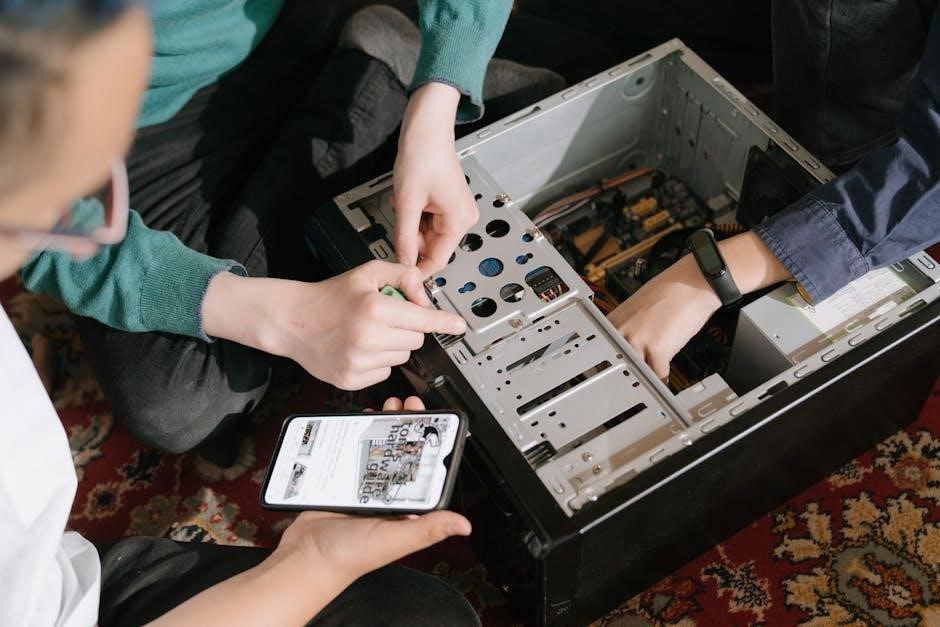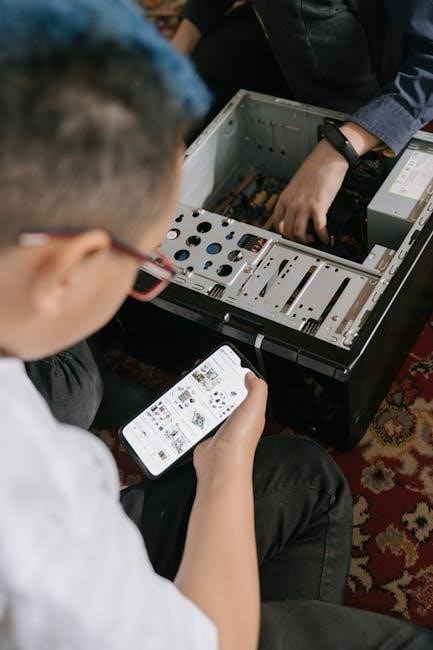Pellet stoves offer efficient, eco-friendly heating, but like any appliance, issues can arise. Troubleshooting is key to maintaining performance, safety, and efficiency. This guide provides a comprehensive walkthrough of common problems and solutions, ensuring your stove operates optimally. Regular maintenance and quick issue resolution will prolong its lifespan and keep your home warm and safe.
1.1 Understanding the Importance of Regular Maintenance
Regular maintenance is crucial for ensuring the efficiency, safety, and longevity of your pellet stove. Neglecting maintenance can lead to performance issues, fire hazards, and even complete system failure. Tasks like cleaning the burn pot, inspecting vents, and checking fuel quality are essential to prevent creosote buildup and blockages. A well-maintained stove ensures optimal heat output, reduces emissions, and minimizes repair costs. By following a routine maintenance schedule, you can enjoy reliable and safe heating throughout the year.
1.2 Overview of Common Issues in Pellet Stoves
Pellet stoves, while efficient, can experience various issues that affect their performance. Ignition problems, insufficient heat output, and error codes are among the most common challenges. Issues like blockages in the venting system or poor fuel quality can disrupt operation. Additionally, faulty components, such as ignitors or combustion fans, may require attention. Creosote buildup and incorrect installation can also lead to inefficiencies or safety hazards. Identifying these issues early is crucial for maintaining optimal function and safety. This guide will help you understand and address these problems effectively, ensuring your pellet stove operates smoothly and efficiently throughout the heating season.

Common Pellet Stove Issues and Their Causes
Pellet stoves often face issues like fuel quality problems, electrical malfunctions, and draft system inefficiencies. These can stem from poor maintenance, blockages, or installation errors, impacting performance and efficiency.
2.1 Ignition Problems and Failure to Start
Ignition issues are a common challenge in pellet stoves, often caused by a faulty ignitor, poor-quality fuel, or electrical malfunctions. A dirty or malfunctioning ignitor may fail to light the pellets, while moist or low-quality pellets can prevent proper ignition. Additionally, blockages in the venting system or incorrect airflow settings can disrupt the combustion process. Error codes on the stove’s control panel may indicate specific issues, such as ignition failure or sensor malfunctions. Addressing these problems promptly is crucial to ensure safe and efficient operation. Always refer to the user manual for guidance on diagnosing and resolving ignition-related issues.
2.2 Insufficient Heat Output or Inconsistent Burning
Inconsistent burning or low heat output in pellet stoves can result from poor-quality pellets, clogged vents, or improper airflow settings. Damp or low-grade pellets may burn inefficiently, reducing heat output. Blockages in the venting system can disrupt combustion, leading to uneven burning. Additionally, faulty ignitors or malfunctioning sensors can cause inconsistent flame behavior. Incorrect settings on the stove’s control panel may also limit heat production. Regular cleaning of the burn pot and heat exchanger can help restore efficiency. Always ensure proper ventilation and high-quality fuel to maintain optimal performance and safety. Addressing these issues promptly can prevent further complications and ensure reliable heating.

Diagnostic Steps for Pellet Stove Troubleshooting
Diagnosing pellet stove issues involves checking fuel quality, venting systems, and components for blockages, damage, or wear. These steps ensure efficient and safe operation of the stove.
3.1 Checking the Fuel Quality and Pellet Supply

Ensuring high-quality pellets is crucial for optimal performance. Moisture content should be below 10%, as higher levels can cause ignition issues or reduce heat output. Check for dust or debris in the pellets, as these can clog the burner or vents. Additionally, verify the pellet supply system, ensuring it feeds consistently. A malfunctioning auger or blocked hopper can disrupt the fuel flow, leading to inefficient burning or stove shutdowns. Always use premium-grade pellets recommended by the manufacturer to avoid operational problems and maintain safety standards.
3.2 Inspecting the Venting System for Blockages
A properly functioning venting system is essential for safe and efficient pellet stove operation. Begin by inspecting the vent pipes for blockages, such as soot buildup, debris, or animal nests. Use a chimney brush to clean the interior of the venting system, ensuring a clear path for exhaust gases. Check for damaged or loose connections in the ductwork, as these can lead to leaks or reduced airflow. Additionally, verify that the vent cap is clear and functioning correctly. Regular cleaning prevents creosote buildup and reduces the risk of fire hazards. Always follow manufacturer guidelines for venting maintenance to ensure optimal performance and safety.

Troubleshooting Specific Components
Identify and address issues with key components like ignitors, fans, and sensors. Replace faulty parts and clean components regularly to ensure proper function and safety.
4.1 Identifying and Replacing a Faulty Ignitor
If your pellet stove fails to ignite, the ignitor may be faulty. Look for signs like no spark or inconsistent ignition. To replace it, disconnect power and let the stove cool. Remove the ignitor by taking out the screws securing it. Inspect for damage or wear; Install a compatible replacement and ensure proper connections. Test the stove to confirm the ignitor works. Always follow safety guidelines and consult the manual for specific instructions. A faulty ignitor can prevent proper combustion, so addressing it promptly is crucial for performance and safety.
4.2 Fixing Issues with the Combustion Fan or Blower
If the combustion fan or blower in your pellet stove is malfunctioning, it can disrupt airflow, leading to poor combustion and reduced heat output. Common issues include worn bearings, blockages, or electrical faults. To diagnose, check for unusual noises, reduced airflow, or error codes. Ensure the venting system is clear, as blockages can strain the fan. If the fan is damaged, replace it with a compatible part. Always disconnect power before servicing. Regularly cleaning the fan and ensuring proper installation can prevent future issues. A functional combustion fan is crucial for efficient and safe operation of your pellet stove.
Error Codes and Their Solutions
Understanding error codes is crucial for resolving pellet stove issues. Models like the Piazzetta P963 M and La Nordica Novella Plus display codes for faulty ignitors, blockages, or vent issues. Ensure proper diagnostics and refer to the user manual for specific solutions. Regular maintenance can prevent errors and ensure optimal performance.
5.1 Decoding Common Error Codes on Pellet Stoves
Modern pellet stoves often display error codes to indicate specific issues. For models like the Piazzetta P963 M or La Nordica Novella Plus, codes may signal problems such as a faulty ignitor, vented system blockages, or low pellet flow. Understanding these codes is essential for quick resolution. For example, an “E01” error might indicate a blocked vent, while “E03” could point to a failed ignition. Always consult the user manual for model-specific code meanings, as interpretations can vary. Addressing these issues promptly ensures safe and efficient operation. Regular maintenance can often prevent errors from occurring in the first place, saving time and effort.
5.2 Resetting the Stove and Clearing Error Codes
After identifying the error code, resetting your pellet stove is often the next step. Turn off the power, wait a few minutes, and restart the stove to clear the code. If the issue persists, refer to the user manual for model-specific reset procedures. For example, models like the Piazzetta P963 M or La Nordica Novella Plus may require pressing and holding the reset button. Ensure all vents and components are functioning properly before restarting. If the error reappears, further troubleshooting or professional assistance may be needed. Regular maintenance can help prevent recurring issues and keep your stove operating smoothly. Always follow safety guidelines when resetting or servicing your stove.
Advanced Maintenance and Repair Tips
Regularly clean the burn pot and heat exchanger to ensure optimal performance. Inspect and replace worn-out components like gaskets or ignitors. Refer to your stove’s manual for specific guidance on advanced repairs and maintenance to keep your pellet stove running efficiently and safely.
6.1 Cleaning the Burn Pot and Heat Exchanger
Cleaning the burn pot and heat exchanger is crucial for maintaining your pellet stove’s efficiency and safety. Over time, ash and debris accumulate, reducing heat output and potentially causing damage. Start by turning off the stove and allowing it to cool completely. Use a stiff brush or vacuum to remove ash and soot from the burn pot and surrounding areas. For the heat exchanger, gently scrub away any buildup with a wire brush. Ensure all components are free from obstructions to guarantee proper airflow. Regular cleaning prevents creosote buildup and fire hazards. Refer to your stove’s manual for specific cleaning instructions and recommendations for professional servicing if needed.
6.2 Servicing the Exhaust System and Chimney
Servicing the exhaust system and chimney is essential for ensuring safe and efficient operation of your pellet stove. Over time, creosote and soot can accumulate, causing blockages and reducing performance. Begin by inspecting the venting system for damage or leaks, ensuring all connections are secure. Use a chimney brush to clean the flue, removing any buildup that could restrict airflow. Regular cleaning prevents creosote buildup, which can pose fire hazards. Additionally, ensure the chimney cap is clear of debris to maintain proper ventilation. For thorough servicing, consider hiring a professional to inspect and clean the entire system every 2-3 years. A well-maintained exhaust system ensures your pellet stove operates efficiently and safely.

Safety Precautions and Best Practices
Ensuring proper ventilation and regular inspections by professionals are crucial for safe operation. Prevent creosote buildup and maintain a clean system to avoid fire hazards and ensure efficiency.
7.1 Ensuring Proper Ventilation and Airflow
Proper ventilation is critical for safe and efficient pellet stove operation. Ensure the venting system is installed correctly and maintained regularly to prevent hazards like carbon monoxide buildup. Regularly inspect the venting system for blockages, damage, or creosote accumulation, which can restrict airflow. A qualified technician should perform annual inspections to guarantee the system’s integrity. Additionally, maintain clear space around the stove to allow adequate airflow for combustion. Keep air intake vents unobstructed to ensure the stove operates within safe parameters. Proper ventilation not only enhances performance but also prevents potential fire hazards and maintains indoor air quality. Always follow manufacturer guidelines for ventilation and airflow requirements.
7.2 Preventing Creosote Buildup and Fire Hazards
Creosote buildup is a significant fire hazard in pellet stoves, occurring when unburned particles accumulate in the venting system. To prevent this, ensure regular cleaning of the burn pot, heat exchanger, and venting system. Using high-quality pellets with low moisture content reduces creosote formation. Maintain proper airflow by cleaning the air intake and exhaust vents regularly. Annual professional inspections are crucial to identify and remove creosote deposits. Additionally, burning pellets at the correct temperature and avoiding low burn settings can minimize buildup. Always follow manufacturer guidelines for cleaning and maintenance to ensure safety and efficiency. Regular upkeep prevents dangerous creosote accumulation and keeps your pellet stove running safely and effectively.
